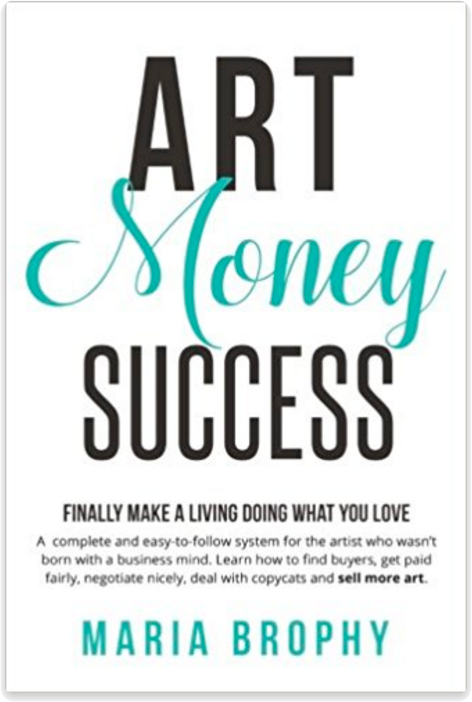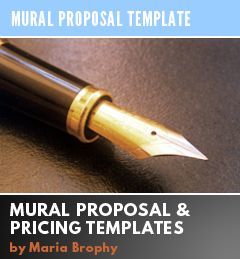Many artists don’t realize that they can say “no” to something that will harm the future of their art.
I want you to know that it’s up to you to enforce the best decisions for your artwork. If a Licensee (or client) wants to print your art on a product that is of poor quality, or they want to sell it in a chain of stores that would harm your brand, you must tell them “NO.”
After all, it’s your art business. You are a business owner, and your art is your brand and it’s up to YOU to decide what will happen with it.
Many artists are afraid to tell a client or an agent “no” to something they feel may harm their future as an artist.
But it’s your responsibility to protect your brand.
What I mean by “brand” is this: The unique features of your work and of your personality make up what is memorable about it. Your brand is what people use to distinguish your work from another artist’s work. If you make too many wrong moves with your “brand” you will harm the public’s perception of it.
For example, if you are a fine artist that sells high priced paintings to collectors, you would harm your future fine art sales if you allowed a client to print your art on low quality products sold in Wal-Mart. On the other hand, if you are an illustration artist who creates designs specifically for mass market products, then printing your art on Wal-Mart products would enhance your brand.
For every artist, the right decisions will be different. You have to determine what is right for your brand and your art.
Everything you do with your artwork will leave an impression with buyers. Everything you allow others to do with your artwork will affect your brand as well.
Knowing this, you must protect your brand from anyone who might harm the vision you have for it’s future.
You can protect your brand by making decisions for your artwork that is in alignment with your future goals and a desires as an artist.
The way you make decisions that are in alignment with your future goals is by knowing what you want and then being confident enough to enforce those decisions with your clients.
If you find yourself in a situation where an agent or a licensee (client) wants you to do something with your art that will harm it’s future, such as printing it on something that isn’t in alignment with your brand; or if they want to make changes to the art that will harm the integrity of it, confidently tell them no.
Say, “I’m sorry, that is not in alignment with my brand or my business model. Let’s do something different instead.”
Remember, no one will care about the future of your art and your brand except YOU.
Have you ever had someone try to do something with your art that you didn’t like?
Or do you have a problem with a client right now, that wants to do something with your work that you feel may be harmful to your future? Please share in the comments and let us know!
Maria xxoo
PS: If you liked this article and want to know more about licensing, sign up for my FREE ten week series called “ART LICENSING MADE EASY” which will teach you how to license your work, negotiate contracts and know what to charge for licensing your art. SIGN UP HERE!












15 Responses
I don’t have such dilemmas yet, but I always feel more confident about my artwork and its value after reading your essays. Thanks~!
Thanks once again for an excellent article, Maria, and one that is right on target for so many artists who are new to art licensing.
We insist on product samples so we can (a) verify that copyright lines are on the product and are done correctly, and (b) verify the quality of the product, or lack thereof. If the product is poorly made, a bad presentation, or just not something the artist would want to have their artwork on, we make our feelings known to the licensee and do no further licenses with them. End of story for that relationship.
But most often the wrong companies for us – that is, companies who don’t produce good product, pay decently, have their act together on production, art usage or distribution, or seem to be difficult to work with – are weeded out before we ever agree to go to license.
In this business, you just can’t be afraid to say “no” when red flags appear and there is no satisfactory resolution to them.
Thanks for your thoughts on this, Lance. So good to hear from you, your website was the first that helped me many years ago when I was learning about Art Licensing! 🙂
Yes! Perfect timing.
I’m a painter as well as an illustrator.
This very morning I was called to a meeting with a bookstore owner who sells prints of my illustrations. He pushed hard for me to start printing my expensive fine art on to CARDBOARD posters, to be sold at the till point for a ridiculously low price. He could not understand what the difference was! I told him the posters he sells for a mere $8 are mass reproductions of retro movie posters, whereas my paintings are original artworks that I spent weeks or months on. He insisted that it makes no difference if printed very cheaply as posters – that anything printed on cardboard is a cheap option for those who can’t afford my paintings. What’s more, he wants half the money, so he literally wants to give me $4 for A3 reproductions of my beautiful wildlife paintings. I was practically speechless. I drove away thinking of how much respect I will instantly lose if I do this. And it made me feel bad about myself… that this lovely old man doesn’t see the real value of my art.
Lisa, thanks for sharing this experience. It perfectly illustrates how for each artist, the decision to print or not to print on cheap products, is a personal one.
If you are selling your paintings at the higher end, then yes, an $8 print will harm your brand and your future art business.
And if you think about, it’s not worth losing the respect or trust from your existing collectors, for a mere $4 a print! You can never get that trust back.
For your art, you made the right decision.
One more thought on this – don’t perceive this man as not seeing the value of your art. He just doesn’t understand your business model nor does he understand your vision for your art. And that’s okay. It’s not for him to understand. He’s not your target market, obviously.
For another artist, selling $8 prints would be just fine. I know many artists who do so and it’s a good business model for them. But, they do not create fine art that is collected by higher end clients, and so, it won’t hurt them.
In your case, keeping your work at the higher price points is the right thing to do.
Hi Maria–
I have obtained valuable information through your web site and so appreciate your insight. It is very hard to find information online regarding artwork licensing. We are working with an startup cosmetic beauty company interested in licensing images for their palette packaging. We feel the product is a good venue for the artwork but to determine if it is a yes or no for the brand is also dependent on the dollar amount of the agreement. I feel the value of the image should reflect the quality of our brand I am not confident on determining a fair flat fee for the image license because, again, information is hard to find. They are offering $1000 for print of 10,000 palettes. How do I determine what is fair rates for this industry and our brand? Thank you, again, for your tenured perspective.
Hi Diane. There are many ways to determine what the licensing fee should be, and it depends on so many different factors, too many to write right now. But, in general, you would want to get between 5-7 % of the gross revenues. So, for example, if they were selling these products to retailers at a $10 wholesale price, and they sell 10,000 of them, their revenues would be $100,000 and if you got a 6% royalty your payment would be $6,000. In this case, $1,000 is way too little for a one-time fee. I recommend you ask what their wholesale price is and then do the math to come up with a fair royalty.
I’m curious about using companies like red bubble and the like for printing. Do any if you have suggestions about where to go to have quality prints made for both paper and clothes/yoga mats/phone cases etc etc? Do you use a local place? Could you point me to one of your articles about this? Many of my clients want prints but I am not set up to make them myself (nor do I want to) and I want to maintain high quality. I also want to find a printing place that is as ecologically conscious as possible. Thanks so much Maria and all of you brilliant minds!
Hi Carla!
I use Red bubble for some of my graphic design work that is typically reproduced at expected to be bought at a lower price point but don’t expect Red Bubble to be where you make a large profit by any means. You can see in their contract the large % they take of your sales and work even though you are not producing the materials of course or shipping. There are pros and cons! You’ll have to decide for yourself I think!
Hello Maria,
Thank you for being you.
I hold TMs on two textural phrases that appeal to a growing market. Can I license the phrases to one company who makes shirts, to another for pottery, and to another for games?
Hello Maria,
I found your website from looking for information on pricing album art, and find your information to be exactly what I was looking for and even more than I expected.
I am an artist who has only been showing art in local galleries for about 3 years with a lot of success, so much so that after a recent show someone inquired about using my art logo as a tattoo.
I was flattered and confused as my brand is very much about using sacred geometry and symbols so I didn’t even think I owned my logo as even though I designed I was heavily inspired by geometry. I told the Inquirer that and suggested she commission someone *me* to make her a tattoo design inspired by my logo, but she really was insistent on “my logo” as her tattoo. She wanted my technical blessing to do it, and would seriously not do it if I said no.
I found it hard to give a solid “no” as I thought she really could just go ahead and do it anyways and I didn’t know how or even if I wanted to stop her. I definitely should think more about the future of these things as my art progresses with more exposure.
Came across your article as I’m trying to find business advice on art selling. I’m not the painter nor the artist; my sister is. She paints gorgeously, with her own style that she has felt comfortable with. Recenty, a close family friend of ours have jusf lost their father, tragic loss. And they were asking me whether my sister had any past paintings of a joyful, beautiful landscape of flowers to decorate their house so that it doesn’t seem so much in grieve. To which I asked I will check, although I doubt any of her earlier paintings are sellable and asked her for a budget. To which she said, a very low price, like the sort of printed framed “paintings” you would buy at Ikea for $25.
So I spoke with my sister about it and the kind-hearted lady she is, she would be willing to create a painting basically for free as long as they provide her the canvas. Bottomline is she will give this painting as a condolonce gift for the loss of the father.
(Little backstory: my sister’s paintings have been in an auction in previous years and due to the successful bidders, her paintings – oil/acrylic based – are worth around $300-600. Their owners are now several top-tier officials and businessmen in Jakarta’s elite society, which I guess with that price is still very low for their usual $100,000++ probably-something paintings)
But my concern is, when asking this family’s friends of mine what kind of painting they would want, they gave me references of subjects that I know is very commercial. Again, those printed-framed knock off paintings of landscapes with very little artistic magic. I know my sister produces great paintings because she uses many colors and abstract forms and she has unique ways to angle her subjects. So once she saw the references that our family’s friends sent over, she bluntly straight up said she can’t paint exactly like that. Which I totally understand, of course!
My question is, should I worry that the art my sister will produce will be something they won’t be able to appreciate, knowing their references of very commercial subjects? Do you think that they are receiving a very nice favor from an artist whose paintings generally definitely does not cost $25? Or should we not take any of this into consideration, in hope that they will appreciate it?
Thank you! I hope you have some really good suggestions after reading your article!
Great post! Yes, I came close to what could have been a nightmare for my brand.
The one day I “accidentally” left my phone in my room while in the studio, I received a call from a movie set designer for a crew that was filming in an island village. They needed art and I happened to have a show in a nearby town. I beat myself up for forgetting my phone that weekend because by the time I got the message, the exhibition space was closed and they’d gone another route. A year later, sitting in the cinema watching this great movie, my heart sank when I saw the room they’d wanted art for. It was called the “tacky house” and my brightly coloured energy-infused visionary art would have been paired with tacky tourist stuff.
Thanks to my guardian angels for helping me “forget” my phone that day. I was in fundraising mode for visionary art school and would have said yes without asking questions.
OMG Dominique! That is quite the story – thank you for sharing it! Goes to show, not all “opportunities” are good ones!
xxoo
I’ve been a designer for the (digital) scrapbooking industry for years but I am new to art licensing.
I was recently in contact with a company that wanted to buy a few of my animal character illustrations outright and they were also going to make some significant changes and I wouldn’t be allowed to share those were my designs. It was too big of a compromise for me so I ended up saying no. What are your thoughts on doing a buyout on (animal) characters vs licensing? I feel like I have a pretty cohesive style and am afraid of losing copyright and not being able to create similar pieces